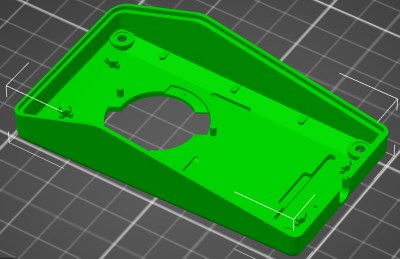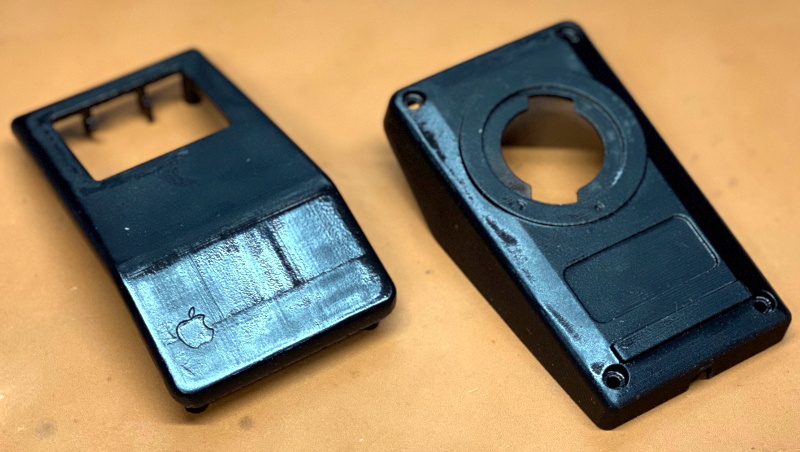At a time when practical graphical user interfaces were only just becoming a reality on desktop computers, Apple took a leap of faith and released one of the first commercially available mice back in 1983. It was criticized as being little more than a toy back then, but we all know how that particular story ends.
While the Apple G5431 isn’t that first mouse, it’s not too far removed. So much so that [Stephen Arsenault] believed it was worthy of historic preservation. Whether you want to print out a new case to replace a damaged original or try your hand at updating the classic design with modern electronics, his CAD model of this early computer peripheral is available under the Creative Commons license for anyone who wants it.

[Stephen] tells us that he was inspired to take on this project after he saw new manufactured cases for the G5431 popping up online, including a variant made out of translucent plastic. Realizing that a product from 1986 is old enough that Apple (probably) isn’t worried about people cloning it, he set out to produce this definitive digital version of the original case components for community use.
With these 3D models available, [Stephen] hopes that others will be inspired to try and modify the iconic design of the G5431. Perhaps by creating a Bluetooth version, or adding the ability to right-click. Considering we’ve already seen custom PCBs for mice, it’s hardly a stretch. We’d love to see somebody take him up on the offer, but even if not, the digital preservation of computer history is always welcome.















Nice modeling indeed. And kudos for uploading not just STLs but also proper 3D models.
Somewhere in history is the idea of ergonomics as applied to mice.
Having tried the original, it is actually not as terrible as it might look like. Though not great either.
Such an improvement over the original Mac mouse, though. The first time I used a Mac SE, it was this mouse that impressed me the most.
Well, the unergonomic mice can be used by both left and right hands.
The ergonomic ones you find to day can’t.
Depending on we look at it, the old mice didn’t discriminate uses as much as the new ones. Seriously, though, I can’t remember when I last time saw a modern mouse for lefthanded people.
The cheap ones are mostly all symmetrical.
Being a left handed, I always used the mouse with my right hand. I never felt it required enough precision as to try switching.
I am left-handed too. And I second that. For me it was ‘another computer to reconfigure and move the mouse’ (because at the time they were wired, and I used shared computers semi-regularly), so I too use mouse with the right hand. No real problems.
I’m right handed and tried at some point learning mouse use with my left hand because it’d be nicer if I kept my dominant hand on the keyboard while doing heavy mousing. Then I got RSI in 1999-2000 and switched to ergonomical (right-handed) trackballs, so the point was moot after that.
That button window is begging for an Amoled touch screen :)
A smartwatch or Galaxy Y maybe: https://en.m.wikipedia.org/wiki/Samsung_Galaxy_Y
An enterprising hacker might even add an OTG Mouse or convert the webcam to a mouse and the whole thing could be wireless over Wifi
This is a very nice model, beauty
I’ll readily grant that 3-d printed items may be functional, but do they have to be so butt-UGLY?
Apparently the concept of “replica” went over your head? Take it up with Apple.
Apparently the concept of “3D-printed parts have poor aesthetic qualities endemic to the materials and the way that parts are fashioned from said materials” went over YOUR head.
3D printing still needs hand sanding.
FDM printing only. Resin printers and SLS are mostly ready out of the machine.
And injection molding needs sprue removal.
And mold release. Complainers complain.
That mouse reminds me of the Genius Mouse, model GM-6.
It also had these flat buttons. Three of them, even! 😁
https://youtu.be/-k2lq6bMnvM
the one thing i liked the most of these mice is the fact that you had to really press the button and thus be able to rest your fingers on the button while idle. modern mice need very little pressure and in idle, you have to lift your fingers, Apple even made a mouse with adjustable switch pressure briefly, albeit with just one button.
Apple mice are always ambidextrous, so a two button mouse where you right-click would never get manufactured by Apple .
This is despite the fact their mice are descended from the xerox mouse which had 3 buttons (select, menu, modify?).
The primary reason for this is that in user interface testing with newbies (ie new Apple employees during its period of rapid growth in the early 80s), they would test them with variants that had more than one button, but kept finding that testers would get confused in some circumstances.
The other possible reason is that a majority of the original core Mac developers were left-handed and normal Windows mice are a problem for lefties.
Conceptually though a one-button mouse is ‘correct’, if function should follow form, because a mouse is really a simulation of a paw and like a paw all you can really do with that is point and push.
A multi-button Mac mouse, if it existed would therefore need rows of horizontal buttons.
In case others do t realise, all modern apple mice are multi touch, thus fine for north or southpaws
Does it have a DB-9 connector on the end? The original Mac mouse sent out discrete signals, quadrature X-Y and the button output, plus a 5v line.
I can’t remember but assume the Lisa used a similar mouse.
The G5431 used ADB, the Mac Plus (and Apple II) mice used DB9. The Apple Lisa looks like a DB9 mouse.
I’d love this being done for the Lisa mouse.
And I would love to do it for the Lisa mouse but first I need to find someone to loan it to me!
PrintedSolid has two interesting PLA colors: ‘beige 500’ and ‘tan 64’. I’ll leave it to the reader to figure out what those are supposed to refer to, but I think they’d be a close match for the case and button respectively of the pre-ADB, pre-Snow White DE-9 Apple mice.
And now that I actually read the post, I know this is a Snow White era ADB mouse and is going to be monotone and lighter than those PrintedSolid colors.
Should be pretty easy to drop the guts of a “Magic Mouse” into it.
Apple mice were ergonomic disasters until the ADB Mouse II M2706. Sony straight up copied its shape with their VAIO PS/2 mouse 179618321, with two buttons split unevenly left and right. Then they added a wheel and split the buttons 50/50 in the model 177220741.
What would be slick is an optical+wireless innards replacement for the 177220741 mouse.
About fifteen years ago i have transplanted a logitech optical mouse’s intestines into a IBM PS/2 mouse.
it worked great, as i kept the original mouse button PCB, still had that rewarding “cluck” sound.
But in everyday life, it was really missing the scrollwheel function.
i have always wanted to attempt that on the software end (like clicking both buttons and moving the mouse to scroll) – but never got around to doing it…